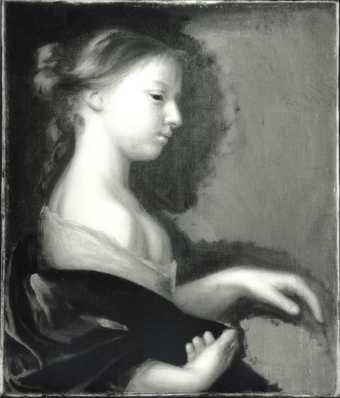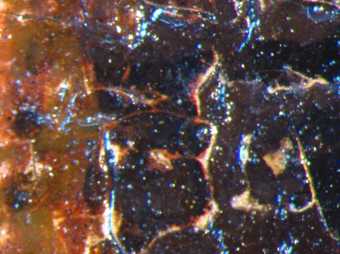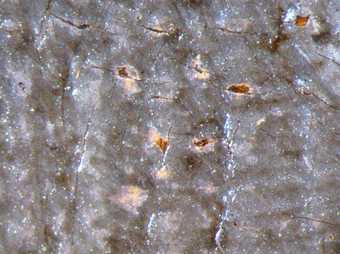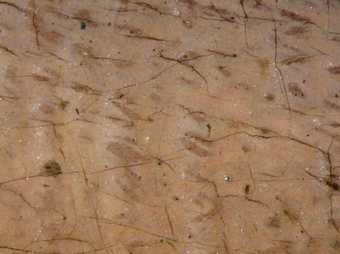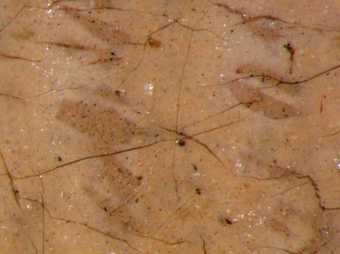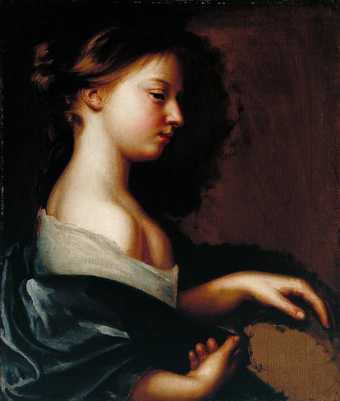
Fig.1
Mary Beale 1633‒1699
Portrait of a Young Girl c.1681
Oil paint on canvas
530 x 452 mm
T06612
This painting is in oil paint on canvas measuring 530 x 452 mm (fig.1). The support is a single piece of coarsely woven plain canvas, with 10 vertical and 12 horizontal threads per square centimetre. The threads are of very uneven thickness with many slubs (fig.2). The fibre was examined at high magnification; while some threads appeared to be linen, others were likely jute or hemp.1 The canvas may therefore be ‘onion bag’, ‘sacking’ or ‘Osnabrug’, three of the types mentioned in the notes kept by Mary’s husband, Charles Beale, who organised the purchase of her materials and primed the raw canvases.2 ‘Osnabrug’ was a coarse cloth of linen or hemp, manufactured in Osnabruck in Germany. Cusping on all four edges indicates that the canvas was primed as an individual piece.3
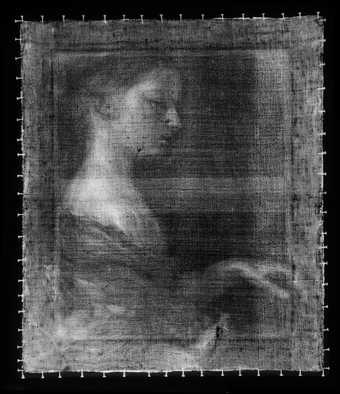
Fig.2
X-radiograph of Portrait of a Young Girl
The ground is a warm grey colour, applied smoothly about 400 microns thick (fig.3). It is composed of lead white, Cologne earth, charcoal black, yellow and red ochres.4 This compares closely with the recipe for ‘Ground for Priming’ given in Charles Beale’s notes on various dates in 1681, as follows: ‘10lb of Good Cereese from Phinner / 6 Ounces ½ & 1/16 of good yellow Oker / 5 Ounces ½ & 1/8 of Cullens Earth 4 Ounces ½ & 3/16 of Ordinary Blew Black / 2 Ounces 3/16 of Burnt Umber / 3 Ounces ¼ of good Red Oker’. Blue black is another name for charcoal black. The absentee pigment, burnt umber, could not be found in polarised light microscopy or with EDX analysis. The ground is visible as the light background tone in the right half of the painting.
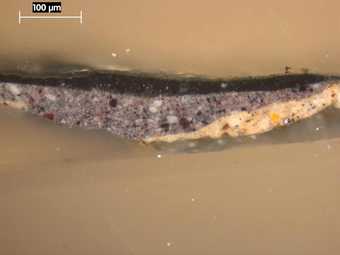
Fig.3
Cross-section of paint and ground from the first black fold on the foreground sleeve, photographed at x225 magnification. It shows, from bottom to top: fragment of warm grey ground, 40 microns thick; opaque purplish grey underpaint, average 35 microns thick; opaque black paint, average 20 microns thick
No underdrawing is visible with the eye or through infra-red examination (fig.4), but microscopical examination reveals that the eyes and other parts of the head were laid in with thin reddish brown paint (fig.5). This examination with the stereomicroscope also reveals dead colouring beneath many areas of the figure (fig.6). (Dead colouring is the initial painted design, usually applied in muted or monochrome tones.) It is generally darker and cooler than the final colours and in the flesh-tones it has a lilac-grey cast (figs.6 and 7). As in the final layers, the principal pigments in the light areas are lead white and charcoal black. A cross-section from the drapery suggests that the lower layer was almost, but not quite, dry when the upper paint layer was applied; the interface between the two layers is very slightly smudged at one point. In the background above her head a dark brown semi-translucent glaze was applied on top of an opaque lighter brown, and the latter was not smudged. This painting, then, is unlikely to be the work of one sitting. Whether the artist intended to finish it or whether it was intended as a preparatory oil sketch is not known.
The paint is opaque, and creamy in consistency; the colours were mixed on the palette and applied wet-in-wet on top of the nearly dry dead colouring. Brushwork is evident but there is no impasto. The pigments in the flesh-tones are as follows: lead white; charcoal black; ultramarine blue; red, yellow and reddish brown earth colours; Cologne earth; chalk; red lake; vermilion.
The painting was cleaned and lined before acquisition by Tate. There are tiny losses of paint and ground on the raised canvas threads all over the painted area (fig.6); these losses have been retouched in most of the figure. The very few losses in the unpainted ground suggest that the painted area developed flaking in the past and was given a treatment to correct it. The varnish is a modern synthetic resin with an ultra-violet filter incorporated; this appears at high magnification as tiny spheres that catch the light in microphotography.
August 2005

